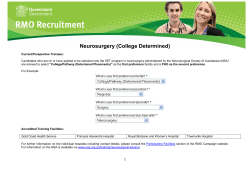
OP25
SESSION 5: Hydrocephalus OP25 How to improve the management of multiloculated hydrocephalus. Surgical outcomes in 91 neuroendoscopic procedures Flavio Giordano, Regina Mura, Raffaele Scrofani, Pierarturo Donati, Federico Mussa, Barbara Spacca, Lorenzo Genitori Department of Neurosurgery, Anna Meyer Children’s Hospital, Florence, Italy Object: The treatment of multiloculated hydrocephalus (MH) is a great challenge in pediatric neurosurgery and despite the advances in neuroendoscopy it is sometimes hard to achieve good results. MH is commonly classified in primary if present at first diagnosis, and secondary as a consequence of CSF-shunting including its complications and multiple revisions. The goal of the present study was to evaluate the effectiveness of neuroendoscopic treatment as an alternative to the placement of multiple shunts to relieve intracranial hypertension, simplify the CSF-shunt system, and to reduce the high rate of shunt malfunction. Methods: We studied 51 pediatric patients with MH who underwent 91 neuroendoscopic procedures. The group included 29 males and 22 females with a mean age of 11 months (range 1 day – 15 yrs). In this series we have divided 12 primary MH (23,5%), and 39 secondary MH (76,5%). MH was further classified in univentricular lateral MH (20; 39,2%), trapped fourth ventricle (13; 25,5%), trapped temporal horn (3; 5.9%), ad multicystic hydrocephalus (15; 29,4%). Etiologies were multiple and sometimes cooccured in the same patients: intraventricular hemorrhage in prematurity (28; 54,9%), infections (22; 43,1%), congenital MH (8; 15,7%), spina bifida (3; 5,9%), tumor (1; 2%), trauma (1; 2%). For all children the total number of operative procedures were recorded. In addition, postoperative complications and radiological follow-up data were analyzed. The range and mean percentage of patients fulfilling the outcome in each group were calculated. Fisher's exact test was used to evaluate differences between groups. Results: The endoscopic procedures included ETV (32), septum pellucidotomy (22), aqueductoplasty with or without stenting (18), intraventricular septa fenestration (16), ventricular cathether lysis (2), choroid plexectomy (1). Surgical morbidity occurred in 13 out 91 procedures (14,3%) due especially to CSF-leakage (4,4%), cranial nerve damages (3,3%) and infections (3,3%). There was only one dead because of hydrocephalus unrelated to surgery. The mean follow-up was 61,8 months (3 mos – 17,9 yrs). In the last follow up 6/50 (12%) patients are shunt-free, 35/50 (70%) with one VP-shunt, and 9/50 (18%) with >= 2 VP-shunts. The number of shunt revisions has been significative reduced from 2,8 to 1,3 per year (p < 0,005). Conclusion: Neuroendoscopy is an efficacious tool to reduce the number of shunts (70% with only one VP-shunt) and shunt-revisions (from 2,8 to 1,3 per year) in complex multiloculated hydrocephalus with an acceptable morbidity and improvement of quality of life. 24th ESPN Congress (Rome-Italy • May 4-7, 2014)
© Copyright 2025





















